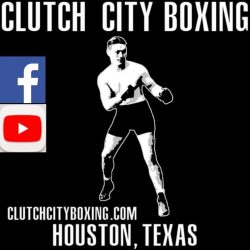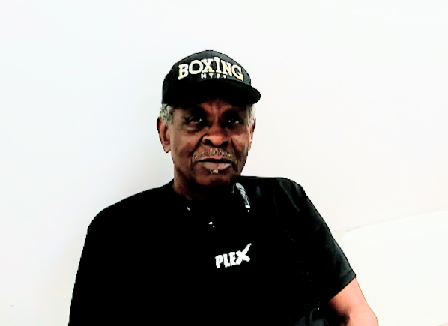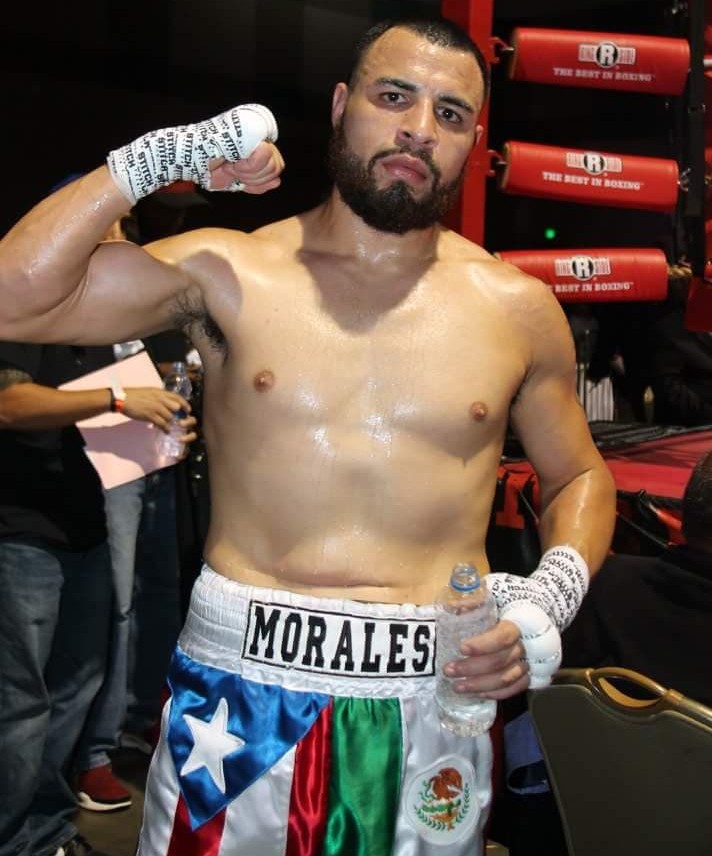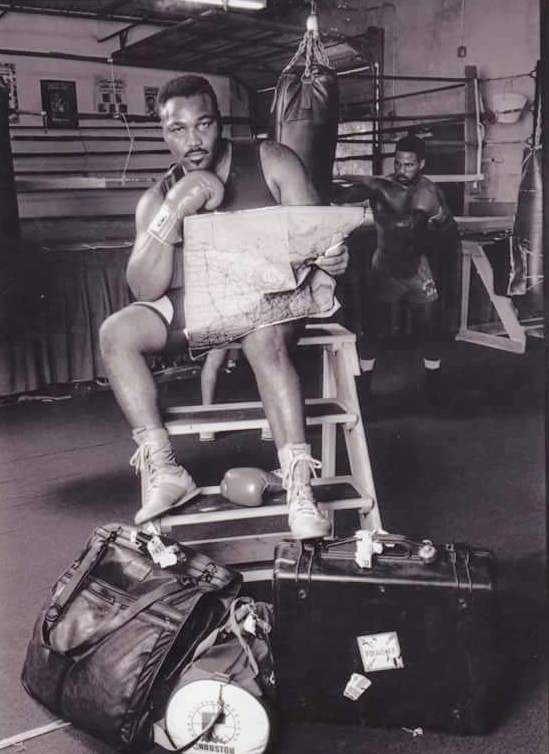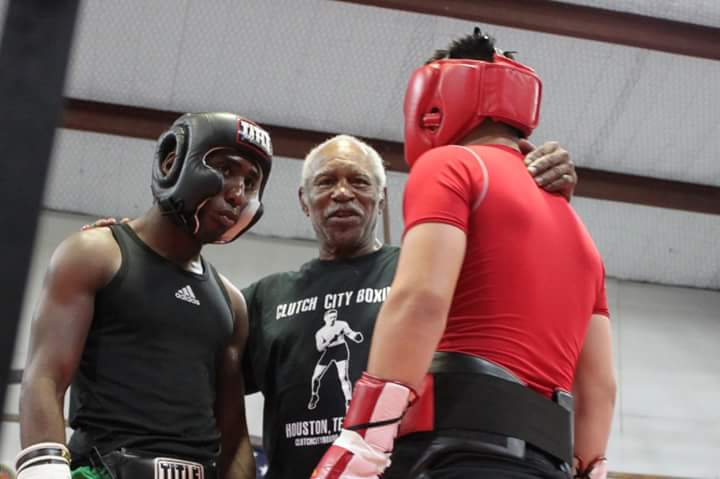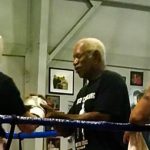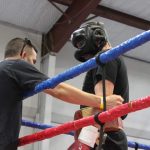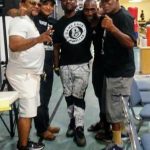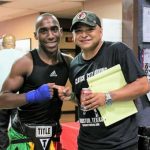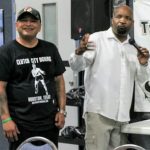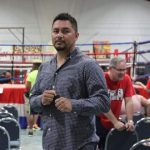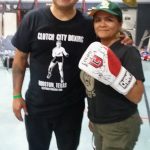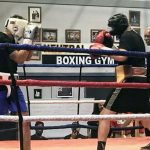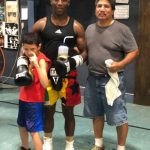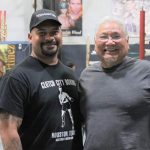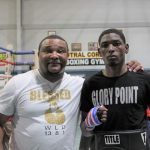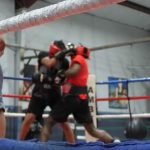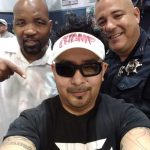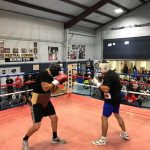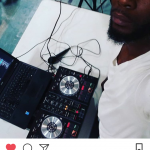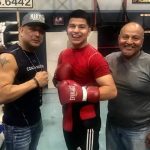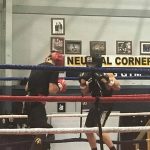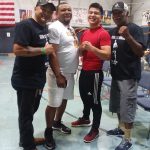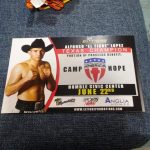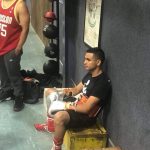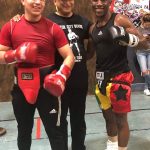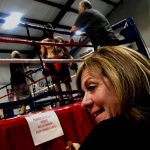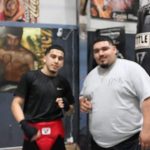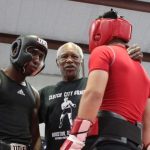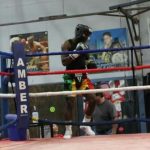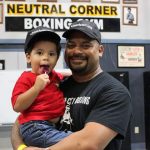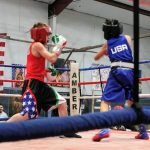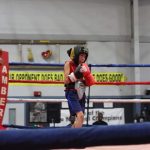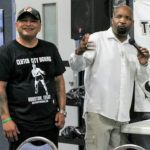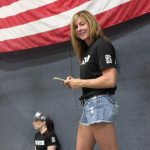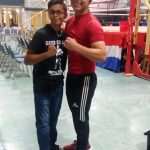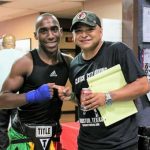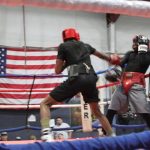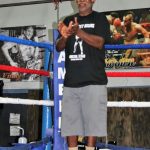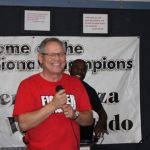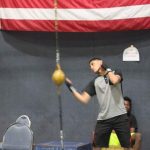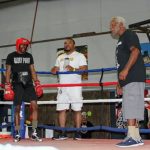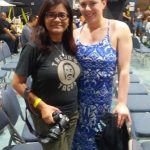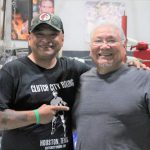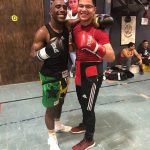10 round heavyweight bout between “Big” George Foreman and Everett “Bigfoot” Martin, both from Houston, Texas. Martin fought out of Savannah Boxing Gym at the time and had Willie Savannah as well as Creed Fountain in his corner.
Creed Fountain
Growing up in Houston, Texas and spending lots of time in it’s boxing gyms, you hear certain names mentioned with reverence when it comes to boxing and all that it entails. Within and between the long hours of time spent in the gym boxers and coaches talk boxing and as young minds often do, the question of “Who’s the best ?” will inevitably come up.
We wanted to know who the best fighters were, the best coaches, the best managers, matchmakers, cut-men, etc and many names were tossed around during those days. One name that always came up when coaches were mentioned was Creed Fountain. Whenever guys had an important professional fight coming up, they usually wanted one of several iconic coaches in town in their corner. Creed Fountain has been one of those guys for the last 45 years and he is still going strong!
I was fortunate enough to be granted a few minutes of Mr. Fountain’s time today at The Plex Performance Center in Stafford, Texas, after he got finished working with former World Champion Erislandy Lara. Mr Fountain was kind and gracious with his time and even suggested we hold our interview in the lobby of the building, so that we would be able to talk without all the background noise of the gym area.
The video of our interview will be below and the transcript of our interview is below the video.
Clutch City Boxing: Sir can you tell us a little about your background and start in boxing?
Creed Fountain: I started a long time ago, back in the 60’s I guess you could say. I was training to be a boxer myself, here in Houston, then I had a car accident and that was the end of that. Then a young boxer at that time named Johnny Baldwin came in. Johnny Baldwin was a bronze medalist and roommate of George Foreman’s in 1968 (Olympics) in Mexico City.
When Johnny came into the city we used to all box and spar with him. After the car wreck I told him, “Man I’m done with boxing” and Johnny said, “No, no, no, no, I want you to train me”. I said, “Man I don’t now nothing about training no fighters”, and he said, “Well we’re gonna learn together”. I said, “Well if that’s what you want, I mean I’m a gym fighter and you are an Olympic fighter, but if you want me to train you, I will”.
So he (Johnny) told his manager Eddie Yates, and Eddie didn’t want me to train him, but Johnny told Eddie, “Look you’re the manager and Creed’s the trainer and that’s the way it’s gonna be”. That’s what got me started in the training business.
Clutch City Boxing: You said you were training to be a boxer yourself before you started training people, who did you train with, or who trained you?
Creed Fountain: Well me and Johnny were working together so Eddie was gonna be my trainer.
Clutch City Boxing: What gym did you guys train at?
Creed Fountain: Oh gosh it was soo long ago, I think it was called Roxy’s Gym, in downtown Houston. It was on the corner of Louisiana and Texas Street, upstairs.
Clutch City Boxing: Who are some of the boxers and clubs that you’ve worked with and around throughout the years?
Creed Fountain: Probably most everybody that came through Houston. I used to work with my boss, Ronnie Shields, I used to be one of his trainers. So I guess all our guys, Reggie Johnson, Bigfoot Martin, Derwin Richards. I’m also a cut-man, you know what my saying was? If your fighter bleeds, call Creed.
So I’ve had the opportunity to work with Juan Diaz, as his cut-man, four time Heavyweight Champion of the World Evander Holyfield, Dominick Guinn, and man it just goes on and on. I’ve practically worked with all the guys from and that came through Houston, most of them.
Clutch City Boxing: I see you’re working with Erislandy Lara now, how about the Charlo twins?
Creed Fountain: Yes I’m working with Lara now, I’m helping out with him, and I’ve also helped worked with the Charlo twins yes. We got a bunch of guys in the gym now that I’m working with.
Clutch City Boxing: In your opinion, what makes a good boxing coach/corner-man?
Creed Fountain: That’s a good question. I would say, just be honest with your fighters, tell them the truth, and make sure they are doing the right thing. I mean a lot of guys go along with a fighter and let him do what he wants to do, you now? You know, if you ain’t doing it right you ain’t doing it right. If you need to do this, you need to do this, to get it right you know? I’m on your side.
Clutch City Boxing: Okay going along those those lines, what difference do you see between boxers today and boxers in your day?
Creed Fountain: There’s a big difference. Boxers of today don’t want to train unless they got a date, most of them. The majority of them, they want to know they have a fight coming up before they do any serious training. Back in my day we went to the gym every day whether we had a fight or not, we just enjoyed going to the gym.
Clutch City Boxing: What do you think makes a good boxer?
Creed Fountain: One that listens. If he listens to the people that are working with him, he should turn out to be a good fighter. And they can’t be lazy, it’s hard work being a boxer.
Clutch City Boxing: What are some of the things a boxer has to have to be successful?
Creed Fountain: A good jab! That’s the most basic thing in boxing, your jab. If you have a good jab, you work behind your jab, you set up everything behind your jab, and everything else will fall in place.
Clutch City Boxing: Who are some of the coaches you’ve worked with throughout the years? Some guys that maybe you’ve learned from and can respect or have respect for what they do, here in town?
Creed Fountain: Well most of them are deceased. There was Al “Potato Pie” Boulden, Tim Goodall, there were a bunch of guys around town. Those guys and also when guys came into town, other coaches like Yank Durham and all them guys, I would learn a lot by listening and watching them. Houston was a fairly decent fight town back in the 60’s and 70’s, a lot of guys came through. A lot of good fighters and coaches. Guys like Dave Zyglewicz, Joe Brown, Mark Tessman, Cleveland “Big Cat” Williams. We had a lot of big fights in town back then and I learned a lot.
Clutch City Boxing: What’s your thoughts on conditioning for a fighter? Do you think he should run every day, 3 or 4 times a week, do you go by feel or? What’s your opinion on that?
Creed Fountain: I ask fighters, I tell them, there are three things in boxing, do you know what they are? Most of them tell me no, they ask what are they? I tell them, Run, Run, and Run. A lot of times you might not have the skill the other guy has, but if you have the condition you can compete with him. That’s our philosophy here, if we can’t beat them in skill, we beat them with conditioning.
Clutch City Boxing: So lots of running, what do you think, like 5 or 6 times a week?
Creed Fountain: Well you pace yourself, you get your pace you wanna run and you do three miles, four miles, however you wanna run. I like outdoor running, a lot of guys they like running on treadmills, but I don’t like that. I like real running, like the old times, out on the road, or on the track, that’s what I like.
Clutch City Boxing: How much gym work do you like your guys to do for a fight? Let’s say a guy is getting ready for a ten round fight, how much sparring should he do?
Creed Fountain: Well it depends, we spar three days a week. We probably start off sparring four rounds, later add to it, go to six, and just kinda keep going up from there. And you take him a full ten rounds of sparring before he gets to fight night. Most guys they do it that way, now an old veteran they aren’t gonna do that. They already know their body and what they can and can’t do, they might spar six or eight rounds. An old veteran that goes twelve rounds, he might spar six or eight rounds. Now these young guys we got, we will take them the full amount of rounds they are going to fight, at least one time in sparring. If they are gonna fight twelve rounds, they are gonna spar twelve rounds, at least once before their fight. With two or three different guys, that way they get a different look throughout that twelve rounds.
Clutch City Boxing: What do you think has made you soo successful throughout the years?
Creed Fountain: Just hard work, coming to the gym, being dependable, being there every day.
Clutch City Boxing: What are some of the things you stress to your boxers? Let’s say you get a guy that is just starting out, or maybe a guy going from amateur boxing to the pros, what would you stress to him?
Creed Fountain: The key to boxing is the jab. If you work behind your jab, everything else will fall into place. I heard Larry Holmes talking one day, saying that coaches don’t teach guys to jab anymore, well we teach our guys to jab.
Clutch City Boxing: Okay one last question. As far as sparring goes, do you believe guys should go easy and work with each other, or kinds go after it? What’s your philosophy on sparring?
Creed Fountain: Well my philosophy is guys need to get in there and work, not to try to kill each other, but work. Now on the other hand sometimes you have a couple of guys get in there and they spar like if they are in a real fight. I will stop them and call them over and tell them, hey guys look, ya’ll are not in a real fight, work with one another, you now?
Clutch City Boxing: So work hard but just working?
Creed Fountain: Yeah work. I mean let him feel it but don’t try to knock him out. Because you know that if you get knocked out in the gym, you won’t be able to fight.
*I then ask him several more questions after I had already told him the last question would be the last* I was just very excited to speak to him and got a little carried away.
Clutch City Boxing: When you are looking at a fighter, what are some of the things you see that let you now you are looking at a good fighter?
Creed Fountain: Well there’s a lot of different things you can look at, the way he keeps his hands up, the way he jabs, the way he moves, his balance, a lot of different things. Also does he listen to his corner when he goes back to his corner? I look at all that.
Clutch City Boxing: Who are some of the guys from back in the days that didn’t maybe make it big in the pros but were really good fighters?
Creed Fountain: Oh gosh there were a lot of guys, Anthony “Wildcat” Wiley, Kent Kneeley, Earl Winbush, Freddie Jackson, Ron Collins, Bigfoot Martin. I mean there’s been a lot of guys that were really good, but just didn’t make it as big for whatever reason.
Creed Fountain: Also when you asked me earlier about guys I’ve worked with, I forgot to mention Frank and Thomas Tate, I can’t leave those guys out. Both were champions, Frank was a gold medalist and a world champion.
Clutch City Boxing: You mentioned Bigfoot Martin, who fought more world and former world champions than most people. How was he able to do that without getting hurt?
Creed Fountain: Well Bigfoot knew how to fight without getting hurt, and he was just a really tough guy in the ring, he could take a good shot. But he fought them all, Larry Holmes, Tim Witherspoon, Bonecrusher Smith, George Foreman, he fought them all!
Clutch City Boxing: Well thank you for your time sir and I appreciate you being so forthcoming with all this information.
Creed Fountain: Thank you, you thought enough of me to come give me a shout out.
Clutch City Boxing: Oh man, your name is heard in gyms all over this town. Maybe not as much now because these young kids don’t know much, but when I was coming up, man I heard you name in gyms all over town. If you came up when I did, and you didn’t know who Creed Fountain was/is, you didn’t do anything in boxing.
Fighter Profile / Alex Morales
In a recent personal conversation with Everett “Bigfoot” Martin, he suggested that I focus more of my time and energy on the young fighters in Houston who may have not had the chance to achieve some of the things he and other Houston “OG’s” have, but are out there trying to represent Houston. I agreed wholeheartedly, thanked “Big Foot” and he finished the conversation by telling me, “Lou, those young guys need the recognition and attention more than us old guys do, we had our time, it’s their turn to shine.”
With respect to “Bigfoot” here is the first of this form of article I’m calling “Fighter Profiles”, introducing a young man with a very inspiring story, local super-middleweight Alex Morales.
Lucky Lou: Alex how did you get started in boxing and where did you get your start?
Alex Morales: I got my start at Mena’s Boxing Club with Coach Howard Mena. I need to back up a little though and explain the circumstances. I have known Coach Howard for many years as a family friend but up until about three years ago, I hadn’t seen him in a long time. He contacted me out of the blue one day and told me he had just opened up a boxing gym near the area where I lived and asked if I would come help him build the gym. I helped him put everything together in the gym and after we were done, he said he wanted to train me in boxing. I was 25 years old, badly out of shape [about 250 pounds], had a poor diet, smoked cigarettes, and didn’t drink anything but cokes.
LL: So I assume you weren’t very enthusiastic about starting up in boxing at the time?
AM: No sir, I resisted, told him I thought I was too old to start and didn’t initially listen when he said I could be a boxer. I think I may have even told him, “You’re crazy old man, it’s too late for me to start”.
LL: What changed your outlook?
AM: Well Coach Howard is a stubborn man and he kept insisting so I eventually gave in and went to his gym.
LL: Was it hard at first?
AM: Yes very hard, I went there thinking I was going to punch bags and what not, but before I could punch even one bag coach Howard made me work on something he called “The Line” which is just what it’s called, a line, taped to the floor that is used to perform a series of balance exercises. With me being overweight at the time and not used to these type of exercises, “The Line” was tough and to make it worse it’s almost the only thing I did for about a month because that’s what Coach Howard said I needed work on! So during that time I met the other two coaches there, Joe Rodriguez and Ricky Stoner, and I started to become addicted to the workout, especially once I was able to do more than just the line exercises!
Although I was getting in shape I would still get discouraged and “quit” for a couple of days here and there, but I always came back.Slowly my weight started dropping and my conditioning began to become the conditioning of a boxer, meaning soon I would be ready to begin sparring.
LL: The fun part, right?
AM: I went into it with no fear and I sparred whoever was available, because by this time I had been bitten by the boxing bug and knew this was something I wanted to do. So many times I was sparring with professional boxers from the area and from Mexico, and took my fair share of butt whuppings, but it built mental toughness and endurance. No matter how bad it looked at times, the old man [Howard] kept telling me that I was going to be a world champ one day and I started to believe it was possible.
About a year and a half into my training I was ready for my first amateur fight, which was going to be held in Pasadena, at The Dynasty Boxing Promotions Gym. A funny thing happened before my first bout though.
I was busy working at a plant and training for my first amateur fight when I started talking to my foreman one day about my upcoming match. I didn’t know my foreman personally but we started talking and he asked me when and where I was going to fight. I told him at The Dynasty Boxing Promotions Show and he immediately laughed and said, “No you’re not”. I was a bit confused and he pulled a piece of paper out of his pocket, read it and said my name wasn’t on the sheet. You see my foreman ended up being Jesse Morales, Owner/Operator of Dynasty Promotions Boxing Gym! I had been training to fight at his show but had not been matched up yet, which is why my name wasn’t on the bout sheet! Luckily I was able to get matched and I did fight, and win at that show, which was the beginning of my boxing career.
LL: You mentioned earlier that you have only been in boxing for about three years, and with two professional wins already under your belt, your amateur career must have been pretty short?
AM: Yes I had two amateur fights fighting under the Mena’s Boxing Club banner and I ended up training and fighting out of Dynasty Promotions Boxing Gym, under the instruction of Jesse Morales for my last three amateur fights. When I left the amateur ranks I had a 4-1 record. My last amateur bout was my proudest moment in the ring so far because my opponent was really good, and tough, he was left handed, and I came into that bout with nothing physically because of a bad weight cut. My opponent was actually maybe the better boxer that night, but I was determined to stop him inside the distance,and going on mostly pure determination, I was able to stop him and get the win. Once I got that last amateur bout in, my Coach Jesse Morales told me I was ready for my first professional bout. Although I was now training full time at The Dynasty Promotions Boxing Gym, I brought in Howard Mena and Joe Rodriguez to help me prepare for my first pro fight, because I knew I needed their help as well, and I wanted them in my corner.
LL: This obviously worked well because you got that first win along with another win since then, leaving you with a 2-0 with 2 KO’s record at this time correct?
AM: Definetly! With Jesse Morales, Howard Mena, and Joe Rodriguez in my corner, I won my first pro fight with a tremendous, one-punch knockout in 43 seconds! My second pro bout was a little tougher because my opponent had an iron chin and was trying his best to win, but I still was able to stop him in the fourth round.
LL: Well Alex it’s been nice getting to know you better and your story is a very inspiring and motivating one for anyone out there that may be out of shape and headed to a road of bad health. You were able to not only leave behind some bad habits and lose weight, you got yourself into fighting condition, which is something very few people can do, with the great demands that boxing makes on a persons mind, body and soul. Is there anything you want to say in parting?
AM: Yes, I want to thank Howard, Joe, and Ricky at Mena’s Boxing, along with Jesse Morales at Dynasty Boxing, for everything that I have learned from them and all the hard work they have put into me. I give it my all everyday because my coaches have always given me their all. I’m still working to perfect my diet and conditioning routine and I believe I can compete as a middleweight in the future. I know I have a long way to go and a lot to learn but I live life one day at a time and I know that I will be a Champion one day! This is my story, Alex Morales super-middleweight, soon to be middleweight boxer and future world champion.
Everett “Big Foot” Martin
Born and raised in Houston, Texas, Everett “Big Foot” Martin faced a virtual who’s who of boxing in the heavyweight division, in a professional career that spanned from 1984 to 2001. Bigfoot also may hold the all-time record for most heavyweight world champions faced, having faced 16 in his professional career, at one point facing 9 in a row!
He began his professional career as a light-heavyweight and cruiser-weight but competed as a heavyweight for most of his career, even though he was relatively small in stature for that division. Although he gave up size for most of his career and faced a murderer’s row of opposition, he was never knocked out and would only be stopped by T.K.O. several times during the tail-end of his career when he was already “tired and worn”.
“Big Foot” was a journeyman that would fight anyone, anywhere, many times with no training camp and on short notice, but still managed to always be competitive, and give the boxing fans an entertaining fight win, lose, or draw. He also held Olympic Champion Chuck Walker to a draw, beat Jesse Selby, Sherman Griffin, “Smoking” Bert Cooper, and Tim Witherspoon by decision, along with knocking down Micheal Moorer.
In an amazing professional career that took him all over the world, he faced many top contenders and champions including:
Jesse Shelby, Sherman Griffin, Olympic Champion Chuck Walker, Kevin Kelly, Vincent Boulware, Tony Willis, Bert Cooper, Johnny Du Plooy, Dwight Muhammad Qawi, George Foreman, Gary Mason, Pierre Coetzer, Francesco Damaini, Micheal Moorer, Riddick Bowe, Tim Witherspoon, Tony Tucker, Larry Holmes, Herbie Hide, Tony Tubbs, Lance Whitaker, Wladimir Klitschko, Danell Nicholson, Lamon Brewster, Fres Oquendo, Joe Hipp,James “Bonecrusher” Smith, Obed Sullivan, David Bostice, Siarhei Liakhovich, and Ruslan Chagaev!
Originally from Fifth Ward, he would later move to Houston’s South Park neighborhood, where he began learning to box first from his mother Mary Martin, who he described as a “tough, street fighting woman” and “Big Al” Alfred Leon Willis, who taught and trained neighborhood boys to box in parks, back yards, and anywhere in the neighborhood, especially in the courtyard of The Villa Americana Apartments. “Big Foot” said that “Big Al” and his mother taught him everything he needed to know in boxing and although he would work with other coaches in his professional career, he would always depend on what he learned from his mother and “Big Al” to get him through anything, along with his faith in God.
A big kid in his youth with a good heart, “Big Foot” hated to see smaller, weaker kids getting bullied in school and would defend them by telling their tormentors, “Hey man, what are you picking on him for, he’s just here doing what he has to do, just like you”. This would inevitably lead to fights with those same bullies and though he didn’t like fighting, backing down wasn’t an option on the streets of South Park and Fifth Ward. After getting in trouble at school for fighting but not necessarily at home since he was fighting to protect those being bullied, his mother decided he needed to box to keep him out of trouble and off the streets. This was when she brought him to “Big Al” Alfred Leon Willis to introduce him to amateur boxing.
“Big Foot” stated he didn’t like boxing initially but eventually became very good at it, partly because “Big Al’s Boxing Club” sparred in the Villa Americana Apartments courtyard and he “Didn’t want to look weak in front of all the homeboys”. He also said that once he started becoming proficient in boxing he began to see boxing as a way he could eventually take care of his family, which was a strong motivation for him. This outlook served “Big Foot” well as he became an elite amateur boxer, winning The Houston Golden Gloves, Open Division, Heavyweight Championship in 1981, 1982, and 1983.
I asked “Big Foot” what skills he learned from “Big Al” that enabled him to become known as one of the toughest, most fearless boxers to ever grace the ring and he said, “He first taught me how to stand correctly and on balance, then how to move in and out and side to side, to be in condition, how to remain calm in the ring, protect myself, control my breathing and punches, and to make my opponent fight how I wanted him to fight, not how he wanted to fight”
I met “Big Foot” only once before calling him today for a phone interview and I must add that he was very gracious about sharing information about his life in and out of boxing. Our interview eventually became more of a private conversation and as a lifelong participant, coach, and fan of boxing I asked him many questions as much as for my personal interests as for this article. One of the main things that intrigued me was how he was able to be competitive against all the contenders and champions he faced over the years without ever being knocked out or seriously injured. “Big Foot’s” response was simple and direct.
“The only reason to be scared of those guys would have been if they were able to hit me and hurt me and I wasn’t about to stand there and let them hit me without moving around and hitting them back, that’s why it’s called BOXING”.
Kenny Weldon Sparring Celebration Photo Gallery

